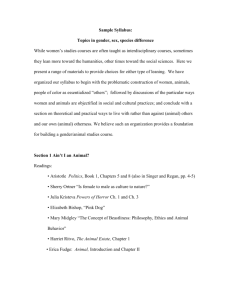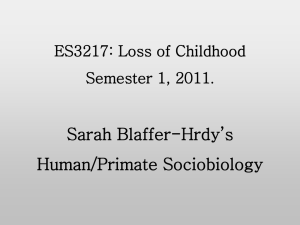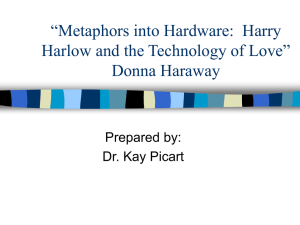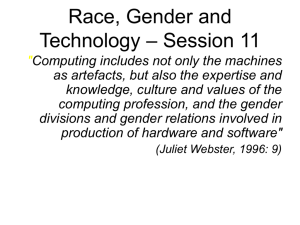Donna Haraway – Master classes and public lecture: April
advertisement
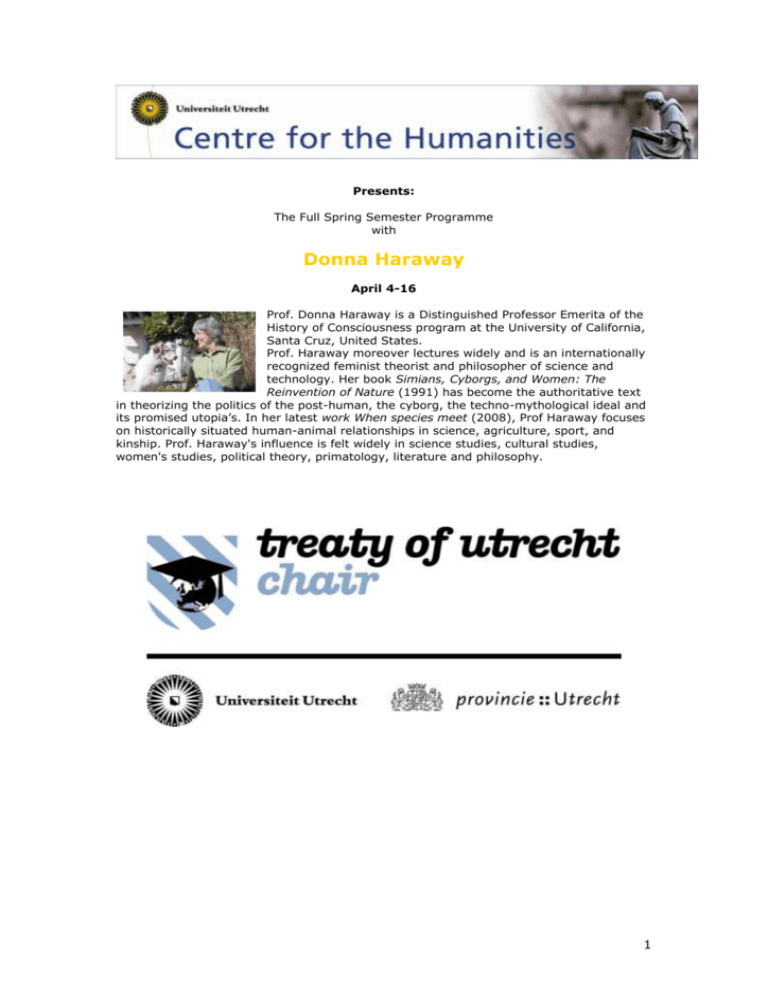
Presents: The Full Spring Semester Programme with Donna Haraway April 4-16 Prof. Donna Haraway is a Distinguished Professor Emerita of the History of Consciousness program at the University of California, Santa Cruz, United States. Prof. Haraway moreover lectures widely and is an internationally recognized feminist theorist and philosopher of science and technology. Her book Simians, Cyborgs, and Women: The Reinvention of Nature (1991) has become the authoritative text in theorizing the politics of the post-human, the cyborg, the techno-mythological ideal and its promised utopia’s. In her latest work When species meet (2008), Prof Haraway focuses on historically situated human-animal relationships in science, agriculture, sport, and kinship. Prof. Haraway's influence is felt widely in science studies, cultural studies, women's studies, political theory, primatology, literature and philosophy. 1 Thursday April 7, 2011 Time: 10:00-17:00 Location: tba Chair: Iris van der Tuin and Rick Dolphijn Public conference 'New Materialism: Naturecultures' and opening of art exhibition ‘Companion Sculptures’ The conference and exhibition are organized by Dr Iris van der Tuin and Dr Rick Dolphijn with participation of Amsterdam-basedsculptor Piet van de Kar (Gouda, 1962) and in collaboration with the Centre for the Humanities. Funded by, among others, the Netherlands Organisation for Scientific Research (NWO). This conference uses Donna Haraway’s concept ‘nature cultures’ as a point of departure. We intend to study conceptual innovation in contemporary cultural theory from seemingly different ‘disciplinary’ and ‘paradigmatic’ angles in order to demonstrate how similar movements in thought are at work in the emerging paradigms of new materialism, posthumanism, agential realism, and in fields ranging from philosophy to the humanities and to the natural sciences. The public exhibition ‘Companion Sculptures’ brings together the scholarly work of Donna Haraway and the artistic production of Piet van de Kar. The project entails the exhibition of several sculptures of Van de Kar in the buildings around Drift in Utrecht. The project is both ‘A Tribute to Donna Haraway’ and ‘A Retrospective of the Work of Piet van de Kar’. Friday April 8, 2011 Time: 16.00-18:00 Location: Aula, Academiegebouw, Utrecht ATGender Conference Keynote by Donna Haraway: "Feminist Worlding: Playing Multispecies Cat's Cradle." The conference is the ATGENDER Spring Conference 2011 'Feminist Legacies, Feminist Futures: connecting research, activism, gender equality and teaching'. ATGender is the newly founded European Association for Gender, Research, Education and Documentation. The aim of the conference is to strengthen the European networks of feminist researchers, educators, students, and gender equality activists along the lines that have been set in the ATHENA network (1999-2009) Prof. Haraway will be re-knotting the cats cradling and relays that are collaborative, coshaped feminist theory for her. For this lecture, her companion species are the thinkers and players with whom feminist worlding is in play. The foreground will be the "becoming with" that is materialist feminist theory. Monday: April 11 & 12, 2011 Time: 10:00 – 13:00 Location: will be announced to participants International Masterclass These two Masterclasses with Prof. Haraway’s will be a retrospective on her work. In two sessions she will be addressing: Science Studies, Culture Studies, Cyborgs and her recent work: ‘staying with the Trouble: Becoming Worldly with Companion Species’ Please note that you can only register for both classes. For more information on registration procedures see here Thursday April 14, 2011 Time: 10:00-17:00 Location: tba Public Symposium: The Human and its animal ‘other’. Speakers: Rosi Braidotti, Donna Haraway and Joanna Bourke The aim of this symposium is to explore and discuss the complex interaction between conception of the Human and its animal ‘other’. The symposium starts from the 2 assumption that the animal, as a figure of otherness is constitutive of human selfunderstanding. The animal shares the function of boundary-marker between the dominant vision of the subject and his others and in this regards shares a position of constitutive otherness with referents such as women, indigenous people and racialized others. Considering the negative dialectics of difference at work in our culture, the constitutive others are the objects not only of denigration but also of violence and abuse. The symposium will not only focus on these aspects, however, but work together a more affirmative formulation of human-animal interaction in the framework of the techno-culture of today. 3

